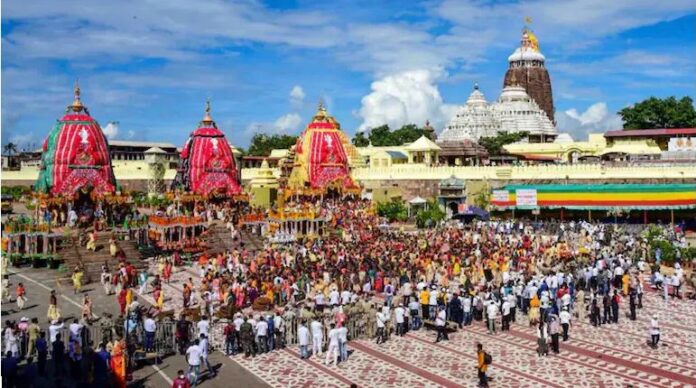Ratha Yatra is a journey in a chariot accompanied by the public. It typically refers to a procession (journey) of deities, people dressed like deities, or simply religious saints and political leaders.The term appears in medieval texts of India such as the Puranas, which mention the Ratha Yatra of Surya (Sun god), of Devi (Mother goddess), and of Vishnu. These chariot journeys have elaborate celebrations where the individuals or the deities come out of a temple accompanied by the public journeying with them through the Ksetra (region, streets) to another temple or to the river or the sea. Sometimes the festivities include returning to the sacrosanctum of the temple.
Many people all around the globe, including India, may be familiar with Odisha as a minor state in East India, but the word Puri has a high recall value for being the land of Lord Jagannath, which is famous for its annual Ratha Yatra. As one of the biggest temples, millions of worshippers visit the Jagannath temple throughout the year to seek Lord Jagannath’s blessings. Puri’s famous Jagannath temple (Shrimandira) was erected in 1078.
Daru Brahma is the name given to Lord Sri Jagannath since his idol at Puri is made of wood, and he is the highest force in the universe. Daru translates to “wood”. Brahma is the cosmic outcome of the cosmos. It signifies limitless and supreme.
The deities are usually worshipped in the sanctum of the temple in Puri, but once a year, during the month of Ashada (usually in June or July), they are brought out onto the main street of Puri and transported (3 km) to the Shri Gundicha temple in huge chariots (ratha), allowing the public to have Darshana (Holy view). This celebration is known as Ratha Yatra, which means “chariot trip (yatra)” (ratha).
This Ratha Yatra (also known as Ghosha Yatra, Gundicha Yatra, and so on) is a one-of-a-kind celebration. It is possibly the only event in which the original idols of Lord Jagannath, Balarama, Subhadra, and Sudarshan (Weapon) emerge from the sanctum sanctorum to be seen by his worshippers.
Nandighosa is the name of Lord Jagannatha’s chariot. It stands 45 feet tall and 45 feet square at the wheel level. It features sixteen seven-foot-diameter wheels and is adorned with a red and yellow fabric cover. Lord Jagannatha is connected with Krishna, also known as Pitambara, the one dressed in golden yellow garments and therefore the canopy’s characteristic yellow stripes.
The Taladhwaja, Lord Balarama’s chariot, is the one with the Palm Tree on its flag. It features fourteen seven-foot-diameter wheels coated in red and blue linen. It stands forty-four feet tall.
Subhadra’s chariot, known as Dwarpadalana, meaning “trampler of pride,” stands forty-three feet tall and has twelve seven-foot-diameter wheels. This chariot is draped in red and black material, with black usually connected with Shakti and the Mother Goddess.
This festival has been celebrated since ancient times and there are several stories associated with its origins.
Story 1: History has it that Lord Jagannatha expressed a wish to return to his birthplace every year for a week. As a result, the deities are taken to the Gundicha Mandir every year.
Story 2: Subhadra longed to go to Dwarka, her parents’ home, and her brothers escorted her there on this particular day. Rath Yatra commemorates that visit.
Story 3: Lord Krishna’s maternal uncle, Kamsa, called Krishna and Balram to Mathura with the goal of murdering them. The demon Kamsa dispatched Akrur to Gokul in a chariot. Lord Krishna and Balram hopped into the chariot and left Gopis for Mathura. This leaving day is known as Rath Yatra.
Story 4: This day is also observed to commemorate Lord Krishna’s transformation into Sarathi – the driver of Arjuna’s chariot – during the Mahabharata’s eighteen-day conflict.
Story 5: In Dwarka, Shri Krishna was cremated. Balaram ran into the water with Shri Krishna’s half charred body, filled with sorrow for his beloved brother Krishna. Subhadra, too, had followed both brothers. At the same time, on India’s eastern coast, King Indradyumna dreamed that the Lord’s body would float up to the shores of Puri. In the city, he should construct a massive mandir and sculpt wooden statues of Shri Krishna, Balaram, and Subhadra. The bones (asthi) of Lord Krishna’s body should be put in the murti’s hollow in the back. The wish was granted. He found the bone splinters (asthi) and grabbed them. Vishwakarma, the god’s architect, appeared as an elderly carpenter and began constructing idols. He stipulated that no one should bother him while he was carving the murtis, and that if anybody did, he would stop working and depart. After a few months, King Indradyumna became impatient and unlocked Vishwakarma’s chamber door. Lord Vishwakarma vanished in an instant, just as he had predicted. The King then erected unfinished idols in the temple. With these idols, a huge Rath Yatra parade is held every year.
The murtis are replaced for every twelve or nineteen years, a practise known as Navakalebar.
Several rites are conducted during the Rath Yatra. The most renowned ceremony, is when “the kings of Puri (Odisha) washes the three chariots way of the deities with a golden broom.” This is just a sign of Odisha’s ancient heritage. Odisha’s monarchs announced themselves to be Lord Jagannath’s servants and ruled.
People of all classes, age groups, caste and communities participate in rath yatra and pull the raths with their hands. Thick topes that are used to pull the ropes are called ‘ Shankhchood’
The 145th Rath Yatra in Puri begins today 1st July 2022. PM Modi greeted the nation ” on the special day of Rath Yatra,We pray to Lord Jagannath for his constant blessings. May we all be blessed with good health and happiness” he tweeted.
 Written by Anil Kumar: Cover Picture PTI
Written by Anil Kumar: Cover Picture PTI

Readers like you, make ESHADOOT work possible. We need your support to deliver quality and positive news about India and Indian diaspora - and to keep it open for everyone. Your support is essential to continue our efforts. Every contribution, however big or small, is so valuable for our future.












It’s amazing to read about the Rathayatra, very nicely explained. Like any ancient stories there are always more than one versions however the essence is in continuing worship and displaying our duties as humans with utter joy and devotion